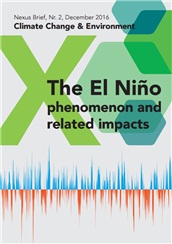The El Niño phenomenon and related impacts
 This nexus brief focuses on the phenomenon of the El Niño–Southern Oscillation (ENSO) and in particular on the 2015/2016 El Niño event, which faded out in May 2016 but has impacts and effects on environmental and societal systems that will extend well into 2017. Efficient monitoring and early warning systems are of key importance for the reduction of the impacts of El Niño–Southern Oscillation (ENSO) variations. A significant challenge is the establishment of effective communication of information available from operational El Niño monitoring and warning systems to targeted recipients. International policy documents provide an appropriate framework for the planning and implementation of actions for combating climate change and climatic extremes. The main task for involved actors is to find suitable measures and feasible actions that are aligned with these global political frameworks and specifically tailored to the local conditions and needs. This document identifies the following key issues to address El Niño and its related impacts: There is an additional need for aid that is put on the global humanitarian system; Long-term effects exacerbate direct impacts; Development agencies must move from relief to adaptation and prevention; International policy frameworks can provide a path toward effective management of El Niño related risks; A priority must be to establish monitoring and early warning systems and improving effective communication.
This nexus brief focuses on the phenomenon of the El Niño–Southern Oscillation (ENSO) and in particular on the 2015/2016 El Niño event, which faded out in May 2016 but has impacts and effects on environmental and societal systems that will extend well into 2017. Efficient monitoring and early warning systems are of key importance for the reduction of the impacts of El Niño–Southern Oscillation (ENSO) variations. A significant challenge is the establishment of effective communication of information available from operational El Niño monitoring and warning systems to targeted recipients. International policy documents provide an appropriate framework for the planning and implementation of actions for combating climate change and climatic extremes. The main task for involved actors is to find suitable measures and feasible actions that are aligned with these global political frameworks and specifically tailored to the local conditions and needs. This document identifies the following key issues to address El Niño and its related impacts: There is an additional need for aid that is put on the global humanitarian system; Long-term effects exacerbate direct impacts; Development agencies must move from relief to adaptation and prevention; International policy frameworks can provide a path toward effective management of El Niño related risks; A priority must be to establish monitoring and early warning systems and improving effective communication.
